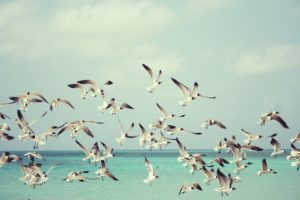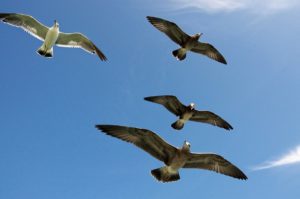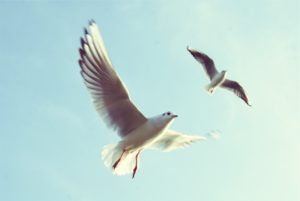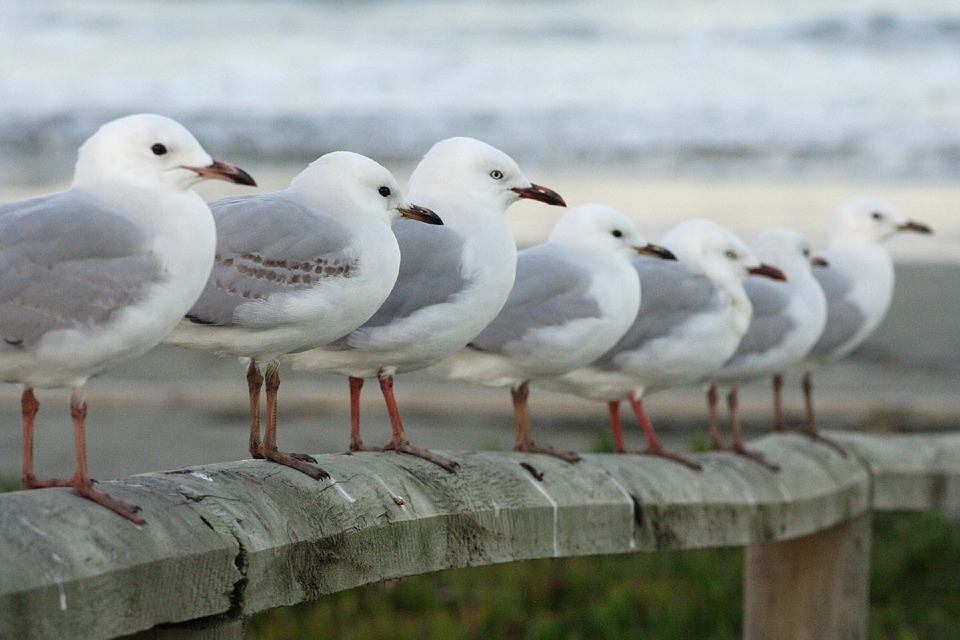Seagulls are grey or white seabirds that often have black markings on their head and wings. There are about 50 known species of gulls found in the world. They can be found all over, including Antarctica, as well as in the coldest regions of the Arctic. Take a look below for 28 more fascinating and weird facts about seagulls.
1. They primarily inhabit coastal regions, but they can also be found near bodies of freshwater.
2. Most gull species have learned to coexist with humans. Some have even managed to thrive in human habitats.
3. An average seagull has a lifespan of between 10 to 15 years.
4. The smallest seagull species is the little gull, Hydrocoloeaus minutus. They can grow to lengths of 25 to 30 centimeters, or 9.8 to 11.8 inches, with a wingspan of 61 to 78 centimeters, or 24 to 31 inches. They usually weigh between 68 to 162 grams, or 2.4 and 5.7 ounces.
5. The biggest seagull species is the great black backed gull, Larus marinus. They can grow to lengths of 64 to 79 centimeters, or 25 to 31 inches, with a wingspan of 1.5 to 1.7 meters, or 4.11 to 5.7 feet. They usually weigh between 0.75 and 2.3 kilograms, or 1.7 and 5.1 pounds.
6. They have a strong body, long bill, elongated legs and webbed feet.

7. Seagulls use a variety of squawks and flaps as a communication system designed to keep order among their species.
8. They live in colonies that can consist of a few pairs of birds to thousands of birds.
9. They have a very strong societal structure that works well on keeping predators away from their breeding grounds. If they see a predator lurking by, up to a hundred gulls will form up to drive the predator away, sometimes even driving them out to sea to drown.
10. Seagulls are omnivores, which means that their diet is both plant and meat based. Their diet consists of fish, marine and freshwater invertebrates, terrestrial arthropods, insects, earthworms, rodents, eggs, carrion, offal, reptiles, amphibians, seeds, fruit, human refuse, chips and other birds.
11. They have even been seen to wait for whales to reach the surface before they land on it and being pecking on its flesh.
12. They’re able to drink both seawater and freshwater, though they prefer the freshwater. They’re able to drink seawater because they have supraorbital glands which remove sodium chloride from their bloodstream.
13. Seagulls are relatively intelligent birds. For example, they have been seen using strategy to find ways to seal food from other animals and eve humans. They have also been found to fly up in the air and drop hard shelled fish so that they could crack the shell and eat the soft meat inside.
14. They prefer to sleep on calm bodies of water, but they will sleep in any wide open spot.
15. Most species are migratory, with many birds moving to warmer climates in the winter.
16. They’re monogamous birds and will mate with the same partner for life.

17. Most seagull species will breed once a year, with their breeding season lasting between 3 to 5 months.
18. The mating pair of seagulls will build their nest together. Most species build their nests on the ground, though some will build theirs on elevated areas, such as trees or cliffs.
19. The female seagull usually lays about 3 eggs, with both the male and female seagulls taking turns to incubate the eggs. Incubation usually lasts up to 26 days.
20. Young seagull chicks are brooded by the male and female seagull for between 1 to 2 weeks, with either the male or female staying with them until they fledge.
21. Both the male and female seagulls will take turns feeding their chicks, though the male does most of the feeding in the beginning while the female protects the nest.
22. Young seagull chicks live in nursery flocks, where they will learn all the skills they need for independent life. They’re usually watched over by a couple of adult males.
23. Some known predators of seagulls are foxes, weasels, sharks and birds of prey, such as eagles.
24. Seagulls have existed on the planet for between 30 and 33 million years.
25. In Irish and Celtic mythology, Manannan Mac Lir was a trickster and the god of the sea. He was often portrayed as a gull.

26. In many cultures, seagulls are symbols of freedom, versatility and a carefree lifestyle.
27. Seagulls have often been seen as spiritual messengers and are often associated with the ability to see different viewpoints.
28. European herring gulls have caused serious head injuries and human deaths as a result of vicious territorial attacks.




